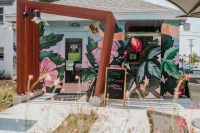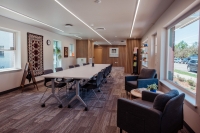The Library Lab: Experiments in Service Design
Salt Lake City Public Library
Innovation Synopsis
In Salt Lake City’s Ballpark neighborhood — one of the city’s most underserved areas — the Ballpark Library Lab is more than a temporary stopgap. This flexible, experimental space is testing how libraries can rapidly embed themselves in a community, co-create services with residents, and pilot new models of access while a permanent branch is planned with the community’s help. By treating the library as a living laboratory, the project demonstrates how small, adaptive expressions of the Library can spark trust, foster connection, and lay the groundwork for long-term community transformation.
Challenge/Opportunity
Access gap: The Ballpark neighborhood had no library branch, leaving thousands — many from underserved backgrounds — without nearby resources, technology, or safe gathering spaces.
Extended timeline: A permanent branch requires major funding, city approvals, and coordination with larger redevelopment — meaning years before a full-service library can open.
Slow-to-act perception: Municipal government is often seen as bureaucratic and unable to respond quickly to emerging community needs.
Limited responsiveness: Residents want services shaped around their own needs and aspirations, but traditional branch models can feel rigid and top-down.
Risk of missteps: New technology, service models, and engagement strategies carry risk; without a low-stakes setting to test them, libraries risk costly failures.
Lost learning: Without an interim space, the system would miss valuable community feedback to inform the design and services of the future branch.
Key Elements of Innovation
Test-and-learn model: The Lab functions as a living prototype: piloting programs, services, layouts, and technology at small scale. Successful ideas are refined and scaled to the permanent branch or replicated system-wide.
Community anchor: Following the loss of a defining neighborhood institution, the Lab serves as a gathering place, resource hub, and point of local pride.
Feedback loop: Data, usage metrics, and resident input shape hours, spaces, and services so the future branch reflects real community needs.
Relationships first: Limited space pushes staff into the community, fostering trust and collaboration with schools, nonprofits, and social service partners.
Experiments with potential: From pop-ups to future pilots like 24/7 access or alternative models, the Lab provides a safe, low-risk setting to test emerging ideas.
Field innovation: More than a building, the Lab establishes an adaptive structure that makes continuous learning core to branch planning.
Achieved Outcomes
Strong usage: Since opening in May 2025, the Lab has welcomed 340 drop-in patrons and hosted 19 community groups. Usage has grown at double-digit rates each month — evidence of strong demand in a neighborhood previously without service.
Positive feedback: Residents call it their “little library,” praising accessibility, welcoming staff, and the chance to shape the permanent branch. Staff report deeper relationships with patrons due to the Lab’s small scale and outreach model.
Community impact: Beyond books, the Lab offers study space, digital access, and social programming — supporting belonging and connection.
Equity outcomes: Early data show high use among families, job seekers, and residents without home internet — groups that benefit most from library access.
Partnerships: Deepened partnerships with key community groups such as the CRA, Ballpark Community Council, Urban Indian Center, and local educational institutions are strengthening local trust and expanding shared impact.



